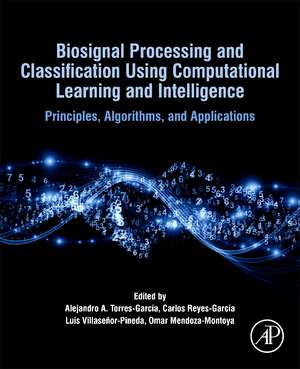Biosignal Processing and Classification Using Computational Learning and Intelligence: Principles, Algorithms, and Applications
Editat de Alejandro A. Torres-García, Carlos Alberto Reyes Garcia, Luis Villasenor-Pineda, Omar Mendoza-Montoyaen Limba Engleză Paperback – 22 sep 2021
- Provides coverage of the fundamentals of signal processing, including sensing the heart, sending the brain, sensing human acoustic, and sensing other organs
- Includes coverage biosignal pre-processing techniques such as filtering, artifiact removal, and feature extraction techniques such as Fourier transform, wavelet transform, and MFCC
- Covers the latest techniques in machine learning and computational intelligence, including Supervised Learning, common classifiers, feature selection, dimensionality reduction, fuzzy logic, neural networks, Deep Learning, bio-inspired algorithms, and Hybrid Systems
- Written by engineers to help engineers, computer scientists, researchers, and clinicians understand the technology and applications of computational learning to biosignal processing
Preț: 815.84 lei
Preț vechi: 1248.79 lei
-35% Nou
Puncte Express: 1224
Preț estimativ în valută:
156.11€ • 162.99$ • 129.20£
156.11€ • 162.99$ • 129.20£
Carte tipărită la comandă
Livrare economică 29 martie-12 aprilie
Preluare comenzi: 021 569.72.76
Specificații
ISBN-13: 9780128201251
ISBN-10: 0128201258
Pagini: 536
Dimensiuni: 191 x 235 mm
Greutate: 0.91 kg
Editura: ELSEVIER SCIENCE
ISBN-10: 0128201258
Pagini: 536
Dimensiuni: 191 x 235 mm
Greutate: 0.91 kg
Editura: ELSEVIER SCIENCE
Cuprins
PART 1 INTRODUCTION
1. Introduction to this book
2. Biosignals analysis (heart, phonatory system, and muscles)
3. Neuroimaging techniques
PART 2 BIOSIGNAL PROCESSING: FROM BIOSIGNALS TO FEATURES’ DATASETS
4. Pre-processing and feature extraction
5. Dimensionality reduction
PART 3 COMPUTATIONAL LEARNING (MACHINE LEARNING)
6. A brief introduction to supervised, unsupervised, and reinforcement learning
7. Assessing classifier’s performance
PART 4 COMPUTATIONAL INTELLIGENCE
8. Fuzzy logic and fuzzy systems
9. Neural networks and deep learning
10. Spiking neural networks and dendrite morphological neural networks: an introduction
11. Bio-inspired algorithms
PART 5 APPLICATIONS AND REVIEWS
12. A survey on EEG-based imagined speech classification
13. P300-based brain–computer interface for communication and control
14. EEG-based subject identification with multi-class classification
15. Emotion recognition: from speech and facial expressions
16. Trends and applications of ECG analysis and classification
17. Analysis and processing of infant cry for diagnosis purposes
18. Physics augmented classification of fNIRS signals
19. Evaluation of mechanical variables by registration and analysis of electromyographic activity
20. A review on machine learning techniques for acute leukemia classification
21. Attention deficit and hyperactivity disorder classification with EEG and machine learning
22. Representation for event-related fMRI
1. Introduction to this book
2. Biosignals analysis (heart, phonatory system, and muscles)
3. Neuroimaging techniques
PART 2 BIOSIGNAL PROCESSING: FROM BIOSIGNALS TO FEATURES’ DATASETS
4. Pre-processing and feature extraction
5. Dimensionality reduction
PART 3 COMPUTATIONAL LEARNING (MACHINE LEARNING)
6. A brief introduction to supervised, unsupervised, and reinforcement learning
7. Assessing classifier’s performance
PART 4 COMPUTATIONAL INTELLIGENCE
8. Fuzzy logic and fuzzy systems
9. Neural networks and deep learning
10. Spiking neural networks and dendrite morphological neural networks: an introduction
11. Bio-inspired algorithms
PART 5 APPLICATIONS AND REVIEWS
12. A survey on EEG-based imagined speech classification
13. P300-based brain–computer interface for communication and control
14. EEG-based subject identification with multi-class classification
15. Emotion recognition: from speech and facial expressions
16. Trends and applications of ECG analysis and classification
17. Analysis and processing of infant cry for diagnosis purposes
18. Physics augmented classification of fNIRS signals
19. Evaluation of mechanical variables by registration and analysis of electromyographic activity
20. A review on machine learning techniques for acute leukemia classification
21. Attention deficit and hyperactivity disorder classification with EEG and machine learning
22. Representation for event-related fMRI
